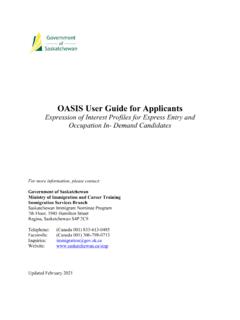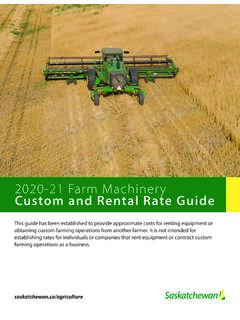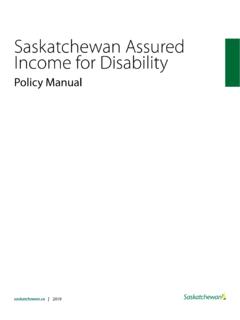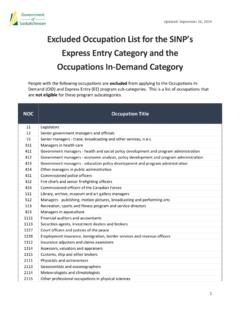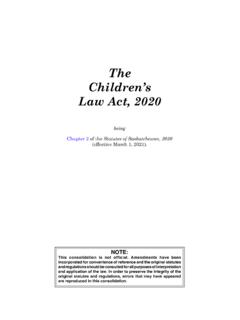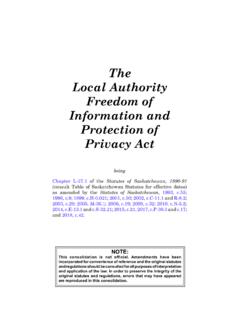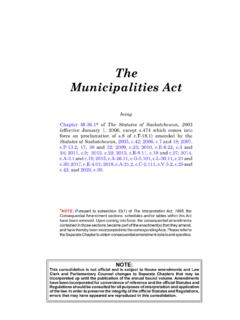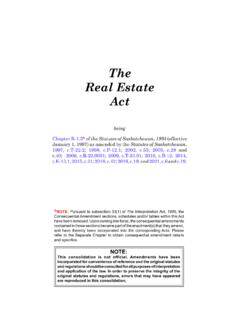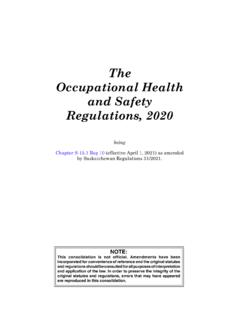Transcription of CLOTHING, TEXTILES, AND FASHION, 10 and 30 - .NET …
1 Clothing, Textiles, andFashion 10, 30 Curriculum GuideA Practical and Applied ArtSaskatchewan Education2000 ISBN: 1-894116-79-8 AcknowledgementsSaskatchewan Education gratefully acknowledges the professional contributions and advice given by the following members ofthe Practical and Applied Arts Reference Cherneski, InstructorSIAST Palliser CampusHazel Lorenz, ConsultantLandswest #123 Saskatchewan Teachers' Federation (STF)Saskatchewan Career/Work Education Association (SCWEA)Dean Lucyk, TeacherRegina RCSSD #81 Saskatchewan Teachers' FederationSaskatchewan Industrial Education Association (SIEA)Barbara McKinnon, TeacherMoose Jaw #1 Saskatchewan Teachers' FederationSaskatchewan Business Teachers Association (SBTA)Lance Moen, DeanAssociated StudiesSIAST Kelsey CampusRose Olson, TrusteeSaskatchewan School Trustees Association (SSTA)Dr. Len ProctorProfessor, College of EducationUniversity of SaskatchewanRon Provali, Teacher/PrincipalPotashville #80 Saskatchewan Teachers FederationSaskatchewan Association for Computers in Education (SACE)Dr.
2 Kevin QuinlanProfessor, Faculty of EducationUniversity of ReginaDoug RobertsonLloydminster RCSSD #89 League of Educational Administrators, Directors andSuperintendents (LEADS)Gayleen Turner, TeacherSwift Current Comprehensive High School BoardSaskatchewan Teachers' FederationSaskatchewan Home Economics Teachers Association(SHETA)Previous Members:Susan Buck, SIASTL aurent Fournier, SSTAM orris Smith, LEADSDave Spencer, LEADSRon Wallace, SCWEAD ebbie Ward, SSTAS askatchewan Education wishes to thank many others who contributed to the development of these guidelines: Linda Ashley, seconded/contracted developer/writer Gayleen Turner, seconded/contracted developer/writer the PAA Program Team field test/pilot teachers, and other field personnel and document was completed under the direction of the Science and Technology Unit, Curriculum and Instruction Branch,Saskatchewan of iIntroduction ..1 Philosophy and Rationale.
3 1 Aim, Goals, and Foundational Components and Considerations ..2 Work Study Component ..3 Assessment and Evaluation ..3 Module Overview ..5 Suggested Course Configurations ..5 Core and Optional Modules ..6 Module 1: Introduction to Sewing (Core) ..6 Module 2: The Basics: Successful Sewing (Core)..9 Module 3: Construction Details - Successful Sewing (Optional) ..13 Module 4: Advanced Successful Sewing and Industrial Techniques (Optional) ..15 Module 5: Design Fundamentals - A Wearable Art (Optional)..17 Module 6: Clothing Decisions (Optional) ..22 Module 7: Redesign, Restore, or Recycle (Optional)..26 Module 8: Fitting and Pattern Alterations (Optional)..28 Module 9: Clothing: A Powerful Resource (Optional)..30 Module 10: Textiles: The Science of Fabric (Core) ..33 Module 11: Textile Applications (Optional) ..40 Module 12: Language of Fashion (Optional) ..43 Module 13: Fashion Industry (Optional).
4 47 Module 14: You, as the Fashion Designer, and Related Careers (Core) ..49 Module 15: Work Study Preparation and Follow-up Activities (Optional)..52 Module 16: Work Study (Optional) ..55 Module 17A, B: Extended Study (Optional) ..56 References ..57 Appendix A: Recordkeeping Chart ..59 Appendix B: Student Evaluation Forms ..60 Basic Sewing Project Board Evaluation ..61 Clothing Lab Evaluation ..62 Design Application , Craft, or Recycling Project Samples Evaluation ..65 Serged Project Evaluation ..66 Sewing Project Evaluation ..681 IntroductionWithin Core Curriculum, the Practical and Applied Arts (PAA) is a major area of study that incorporates five traditional areasof Home Economics Education, Business Education, Work Experience Education, Computer Education, and Industrial ArtsEducation. Saskatchewan Education, its educational partners, and other stakeholders have collaborated to complete the PAAcurriculum renewal.
5 Some PAA curriculum guides have been updated; some components have been integrated, adapted, ordeleted; some Locally Developed Courses have been elevated to provincial status; and some new guides have companion Practical and Applied Arts Handbook provides background on Core Curriculum philosophy, perspectives, andinitiatives. The Handbook articulates a renewed set of goals for PAA. It presents additional information about the PAA areaof study, including guidelines about work study, extended study, and the Transition-to-Work dimensions. In addition, a PAAI nformation Bulletin provides direction for administrators and others regarding the implementation of PAA courses. Lists ofrecommended resources for all guides will be compiled into a PAA Bibliography with periodic and RationaleThe renewed Clothing, Textiles, and Fashion curriculum guide is designed to create awareness of the role of clothing, TEXTILES, and fashion in our daily lives.
6 Modules are developed for the student who has the desire to learn to sew and/ or designclothing and textile products. Modules will provide the student with the opportunity for achievement and success through acombination of theory and practical experiences within the school and/ or the trend toward self-employment and small business, the knowledge and skills acquired can be transferred into theworld of , Goals, and Foundational ObjectivesAimThe Clothing, Textiles, and Fashion curriculum guide focuses on developing an understanding of key theoretical concepts andon practising skills associated with the areas of clothing, textiles, and fashion. There is a balance of personal and work-basedskills promoted throughout the guide . Practical application of the knowledge and skills will be demonstrated in projectsreflected at both the personal and work Knowledge: To develop a knowledge base that will enable students to develop buying practices when shoppingfor clothing and textile Skills: To allow students to cultivate practical clothing skills that can be used in their daily Advances: To gain knowledge of the changes in the production of clothing and in the textiles industries andhow they influence the lives of people and Employment: To explore career opportunities that may lead to successful employment in the areas of CLOTHING, textiles, and : To develop entrepreneurial skills and evaluate opportunities within the textile and fashion ObjectivesFoundational objectives are the major, general statements that guide what each student is expected to achieve for the modulesof the PAA curriculum guide .
7 Foundational objectives indicate the most important knowledge, skills, attitudes/values, andabilities for a student to learn in a subject. Both the Foundational Objectives for Clothing, Textiles and Fashion 10, 30 andthe Common Essential Learnings (CELs) Foundational Objectives to be emphasized are stated in this document. Some ofthese statements may be repeated or enhanced in different modules for emphasis. The Foundational Objectives of the CoreModules of the Clothing, Textiles and Fashion 10, 30 curriculum include: To understand, develop, and apply the major concepts related to clothing construction. To provide a broad foundation of clothing design fundamentals and apply them to projects to meet individual needs. To generate an awareness of the factors that determine the appropriateness of successful design in apparel and textileproducts. To increase awareness of the economic and environmental influences on clothing decisions.
8 To provide opportunities to use the decision making process in clothing selections. To identify and apply principles of clothing care. To develop skills in designing, restoring, or recycling clothing and textile items. To acquire an understanding of the concepts related to fitting standards and pattern alterations in the clothing and fashionindustry and apply these concepts to the fit and appearance of a garment. To recognize that clothing, fashion, and textile items evolved from culture and reflect the economic, political, and socialconditions of the times. To create a broad awareness of textiles uses in apparel, home furnishings, commercial furnishings, and industry. To examine, create, and evaluate a variety of textile design applications suitable for clothing and textile items. To explore and practise the fashion design process. To integrate classroom learning with work-related learning. To create an awareness of the careers and opportunities in the fields of clothing, textiles and fashion industries that existin Essential Learnings Foundational ObjectivesThe incorporation of the Common Essential Learnings (CELs) into the instruction of the Practical and Applied Artscurriculum offers many opportunities to develop students knowledge, skills, and abilities.
9 The purpose of the CELs is toassist students with learning concepts, skills, and attitudes necessary to make the transition to career, work, and adult CELs also establish a link between the Transition-to-Work dimensions and Practical and Applied Arts curriculumcontent. The Transition-to-Work dimensions included in the PAA courses are: apprenticeship, career development,community projects, employability skills, entrepreneurial skills, occupational skills, personal accountability, processing ofinformation, teamwork, and work study/experience. Throughout the PAA curricula, the CELs objectives are stated explicitlyat the beginning of each module. The CELs are coded in this document as follows:COM =CommunicationNUM=NumeracyCCT =Critical and Creative ThinkingTL =Technological LiteracyPSVS =Personal and Social Values and SkillsIL = Independent LearningIt is anticipated that teachers will find additional ways to incorporate the CELs into their classroom Components and Considerations Each Secondary Level credit is based on 100 hours of instruction.
10 It is necessary to provide a balance between theory andpractice. The renewed Clothing, Textiles, and Fashion modules begin at the basic sewing level using commercial patterns,sewing machines, and sergers when available. Introductory modules from Clothing, Textiles, and Fashion 10 will berecommended for the Middle Level. School and community diversity will determine the work study employment opportunities in your locale. The optional work3study component of 25 to 50 hours provides the student with the opportunity to apply classroom learning to the workplacesetting and further develop career exploration. The work study component will be determined by arrangement with theemployer, student and teacher monitor. Career exploration, Transition-to-Work, and a smooth transition from high school to post-secondary education programs areimportant goals in all PAA courses of study. This course is a Practical and Applied Arts option that is a specified elective atthe Secondary Level.
